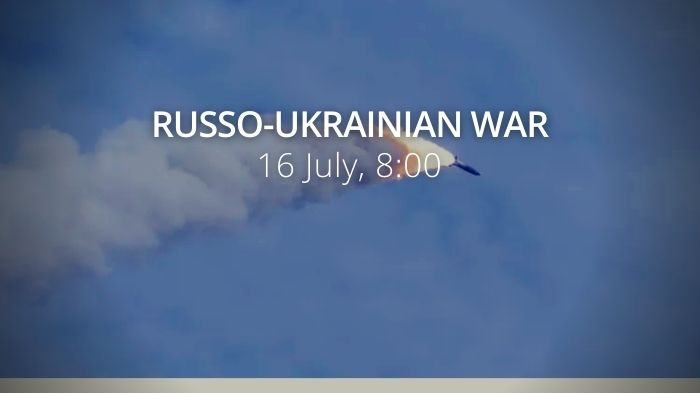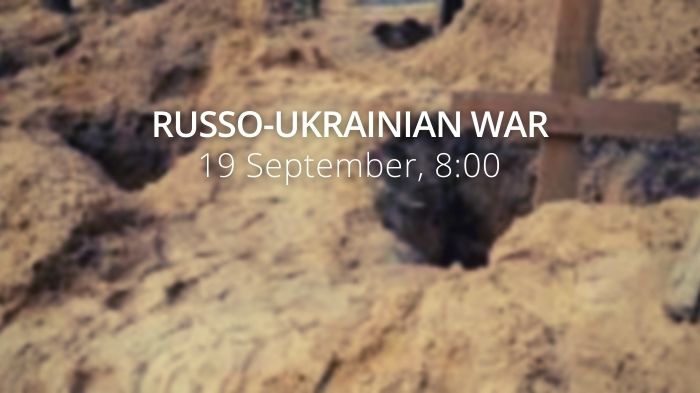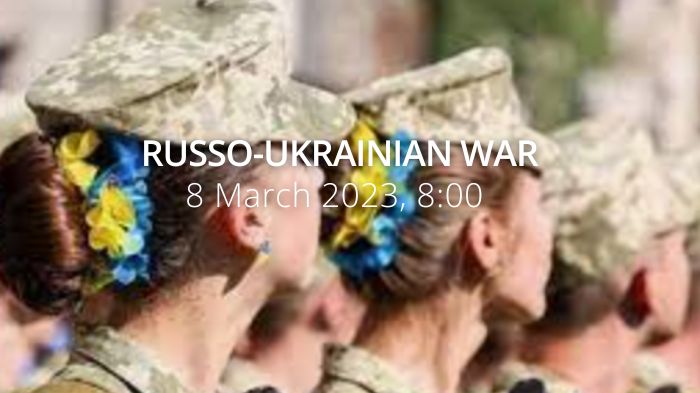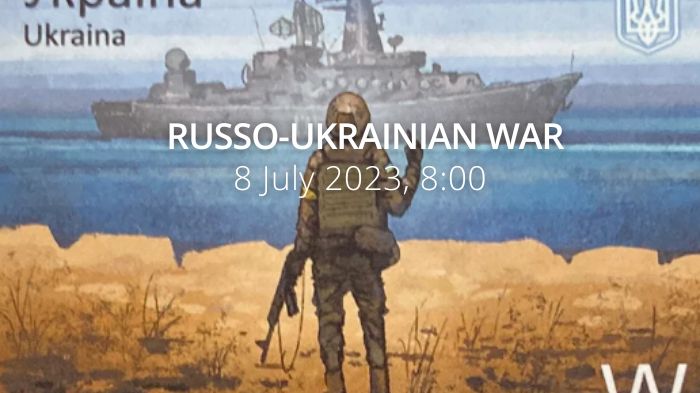Russia resumes long-range bombardment of Ukrainian cities. Ukraine strikes significantly reducing Russia’s offensive potential. Missile strike on the Dnipr: Four x-101 missiles destroyed. Russia fired 630 Iskander and Kalibr missiles at Ukraine since the war began. Russian offensive operations remain reduced in scope and scale. Ukrainian defense has been successful in repulsing Russian attacks since Lysychansk was ceded and the Ukrainian defensive line was shortened and straightened. As a Ukraine grain deal emerges, the US aims to ease concerns over Russia sanctions.
Daily overview — Summary report, July 16
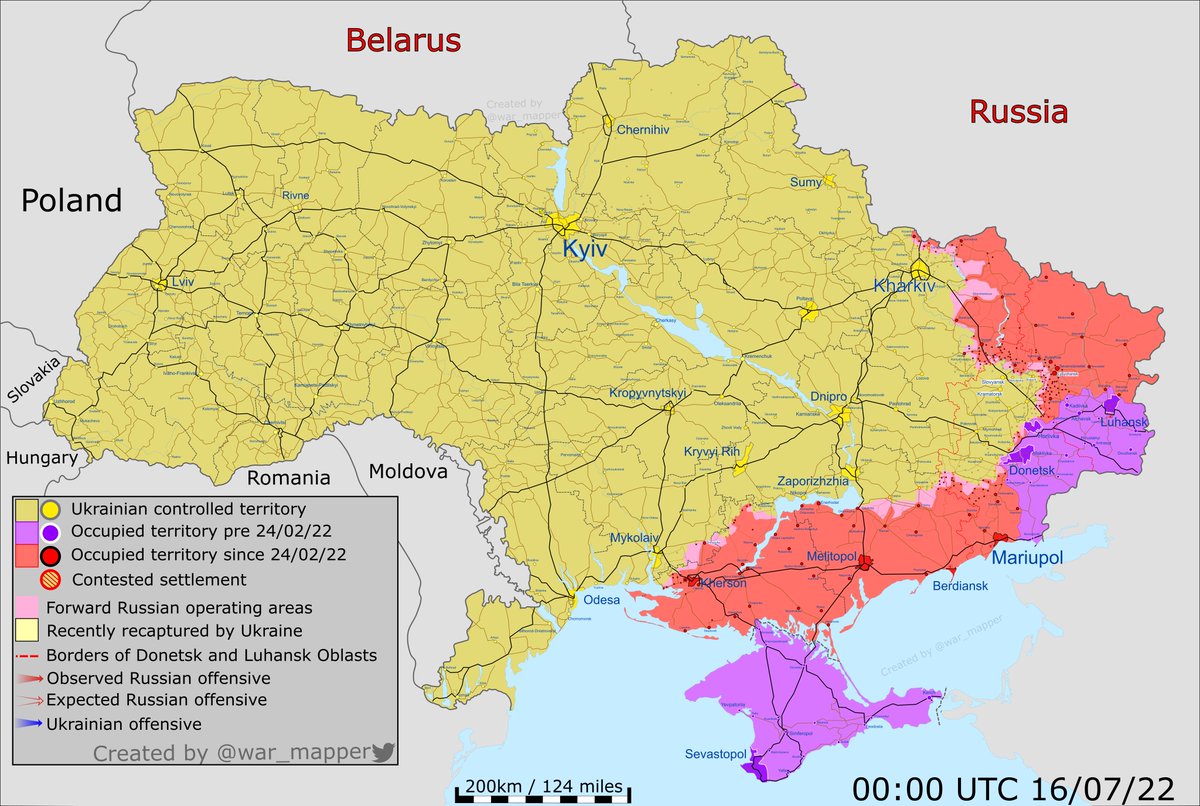
According to military expert Stanislav Haider, as of July 16,
Donetsk Oblast. Fighting continues in the area of Bohorodychne as the Russians can’t capture the village completely. Near Krasnopillia, Ukrainian forces repelled a Russian attack. For the third day now, the Russian propaganda disseminates fake reports on “street fighting” in Soledar and Siversk which both actually remain under Ukrainian control as the front line doesn’t reach their city limits for now.
South of Donetsk Oblast. There were no changes in the Velyka Novosilka area where both sides mostly carry out tactical actions. In the area of Vuhledar, the Ukrainian military continues to advance. In the direction of Mariinka, Ukraine holds defense and gives a good response to Russian attacks.
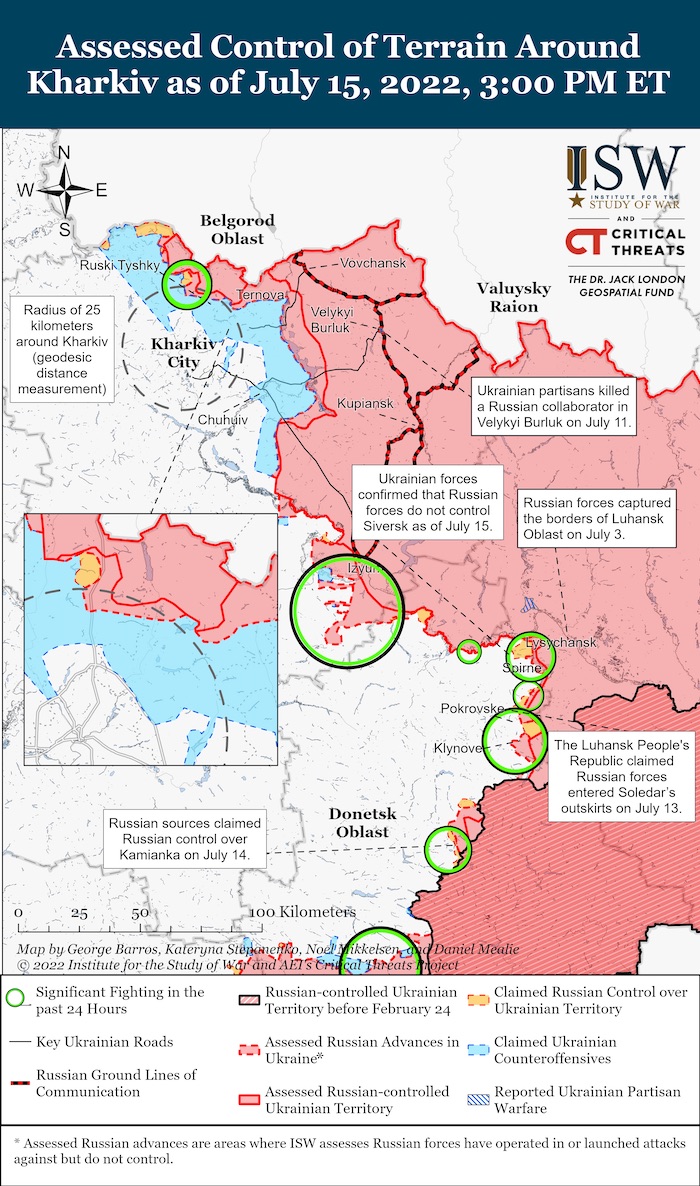
Kharkiv Oblast. The Ukrainian Armed Forces repel limited Russian attacks and keep the possible routes of their advance near the border under fire control. No changes occurred at the Pechenihy Reservoir and west of Izium, where the Russian troops on the border area “were beaten quite badly and invited reinforcements, which they expect for the 4th day now.”
The Russian command reluctantly spends the operational reserve stationed near Belgorod, because it was formed for an offensive on Sloviansk. Now they have to use this reserve to replenish losses in the oblasts of Kherson, Kharkiv, Zaporizhzhia, and the south of Donetsk Oblast.
https://twitter.com/EuromaidanPress/status/1548258642289340416
Zaporizhzhia oblast. There are no changes on the lines of Polohy-Inzhenerne and Nesterianka-Vasylivka. The Armed Forces of Ukraine resumed active operations in order to push forwards the front line from Orikhiv and Huliaypole as far as possible. On this front, Russians have been actively rotating lately, though the quality of the replacement troops is low as instead of Russian regulars here mostly come the forcefully mobilized residents of the long-occupied areas of Donetsk and Luhansk oblasts.
Kherson Oblast. Ukrainian troops successfully defend the newly retaken positions at Inhulets, west of Kherson, and in the Visokopillia area.
The work of Ukrainian artillery. At night, the HIMARS successfully hit several Russian warehouses and locations where the Russian troops are stationed in Kherson Oblast and in the Snihurivka area. The Ukrainian artillery also hit Kadiivka, Donetsk, Khartsyzk, and Makiivka.
The General Staff’s operational update regarding the Russian invasion as of 06.00 am, July 16, 2022 is in the dropdown menu below.
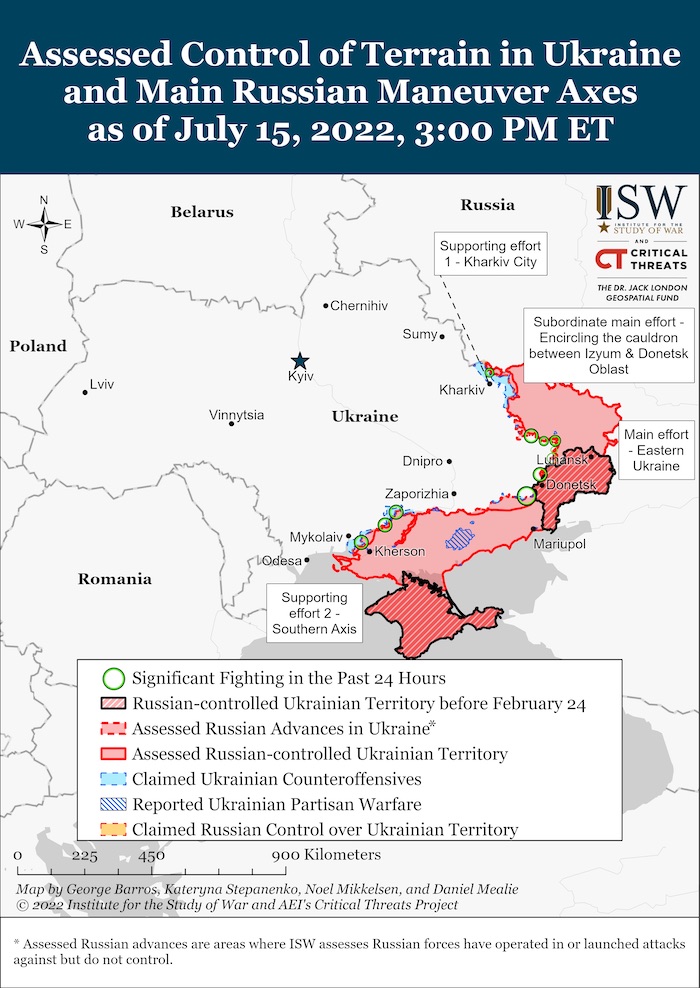
“Russian occupiers continue to launch rocket attacks on civilian objects on the territory of Ukraine.
In the Volyn and Polissya directions, no significant changes in the position and activity of the units of the armed forces of the Republic of Belarus in the border areas with Ukraine were noted. [In the airspace of the Republic of Belarus, the rotation of the A-50U long-range radar detection aircraft of the Air and Space Forces of the Armed Forces of the Russian Federation is noted. The threat of missile and air strikes from the territory and airspace of the Republic of Belarus remains.]
Military exercises in Belarus were extended at least until July 23
It is indicated by the schedule of their holding at the Belarusian training grounds (map). The total number of training extensions is already 12 weeks, monitoring group Belarusian Hajun https://t.co/tQnyMiHlTT pic.twitter.com/uNvv3YjmeR
— Euromaidan Press (@EuromaidanPress) July 16, 2022
In the Siverskyi direction, Russian forces fired mortars at the positions of our troops near Zarutskyi, Starykyve and Budivelne, Sumy oblast. [In the Siversky direction, in order to demonstrate the presence and constrain the actions of the Defense Forces, Russian forces keep up to four battalion tactical groups in the border areas of the Bryansk and Kursk regions. Yesterday, the occupiers fired at our positions near Kucherivka and Pokrovka, Sumy oblast.]
[In the Slobozhansky direction, Russian forces yesterday used artillery and MLRS to shell the districts of Kharkiv, Stara Hnylitsa, Ruska Lozova, Ukrainka, Ruski Tyshky, Peremoha, Mykilske, Slatyne, Zolochiv, Krynychne, Chepil, Novomykolaivka, Nova Dmytrivka, Dibrovne, Bohorodychne, and Karnaukhivka. Made an airstrike near Verkhniy Saltov.]
- In the Kharkiv direction, Russian forces are concentrating their main efforts on preventing the advance of our troops. Conducted an airstrike near Mospanove. It carried out artillery shelling in the areas of Kharkiv, Pytomnyk, Novopokrovka, Protopivka, Ruski Tyshky, Duvanka and Korobochkyne settlements.
- It carried out an airstrike in the Sloviansk direction near Bohorodichne.
- Artillery shelling was recorded in the areas of Dibrovne, Chepil, Kostyantynivka, Novomykolayivka, Mazanivka, Bohorodychne, Mykilske and Husarivka settlements.
- [Yesterday, Ukrainian soldiers again successfully repelled an assault, during which the occupiers tried to establish control over Bohorodychne.]
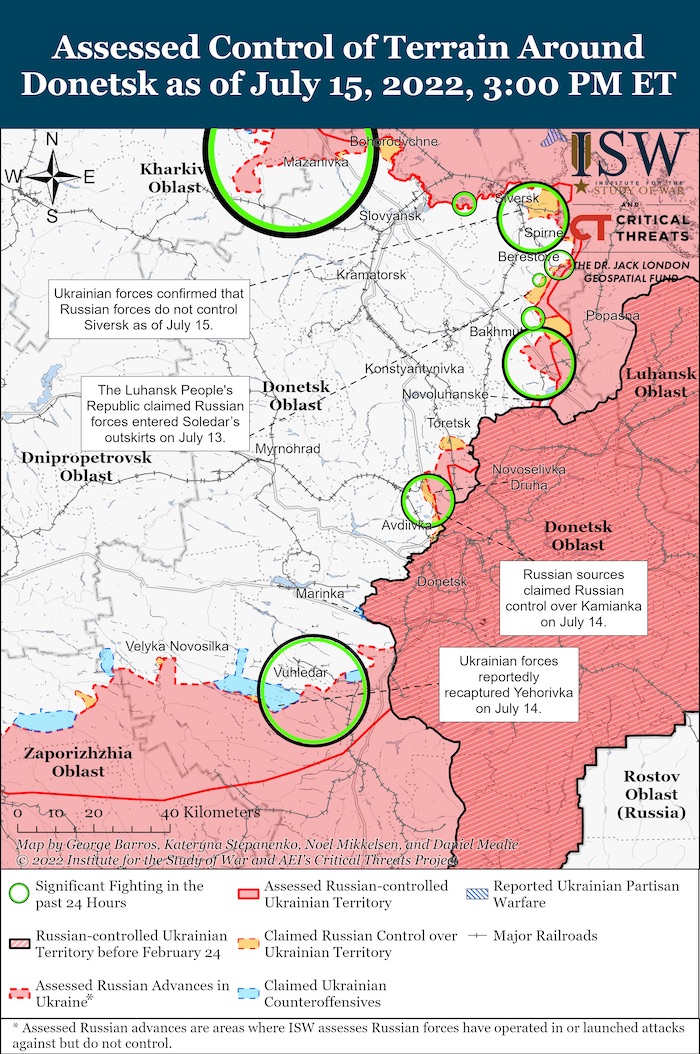
In the Donetsk direction, Russian forces shelled the districts of Zakitne, Siversk, Hryhorivka, Tetyanivka, Donetsk and Raihorodok. Our defenders successfully repulsed the offensive of the occupiers in the direction of Spirne – Ivano-Daryivka. [In some areas, Russian forces intensified the use of aviation, artillery and MLRS to expand the temporarily occupied territory and reach the administrative border of the Donetsk region.]
- In the Bakhmut direction, Russian forces carried out airstrikes near Berestove and New York. It carried out artillery shelling in the areas of the settlements of Berestove, Soledar, Zvanivka, and Semihirya. [Yesterday, the occupiers tried to take control of the section of the Bakhmut-Lysychansk road. Assault operations were conducted in the direction of Nahirne and Bilohorivka. Ukrainian soldiers stopped all these poor attempts of Russian forces with fire and pushed it back.]
- Enemy assault attempts in the directions Dolomitne – Novoluhanske and Dolomitne – Semihirya were stopped under the effective fire of Ukrainian soldiers. The same fate befell the occupiers in the direction of Roty – Vershyna. Russian forces retreated. After regrouping, it resumed the attack on the Vuhlehirska TPP, and hostilities continue.
- [Yesterday, Russian forces carried out airstrikes in the areas of Verkhnokamianske, Ivano-Dariivka, Kramatorsk, Berestove, Bilohorivka, Pokrovske, Soledar, Nova Kamianka, Paraskoviivka, Bakhmut, Vesela Dolyna and New York. Missile and airstrikes were recorded near Bilohorivka, Yahidne, Bakhmut, Avdiivka and Novoselivka.]
- [Yesterday, the invaders also made several unsuccessful attempts to improve their tactical position in the Mykolayivka – Spirne, Myronivka – Vuhleghirska TPP and Vidrodzhennya – Vershyna directions. As a result, the occupiers suffered losses and retreated.]
- [An attempt to improve the tactical position in the directions of Solodke – Vodyane, Volodymyrivka – Vodyane, and Yehorivka – Pavlivka ended with significant losses for the Russian occupiers. Under the fire of Ukrainian soldiers, the remnants of Russian forces’ forces retreated.]
- In the Avdiivka, Kurakhivka, Novopavlivka and Zaporizhzhia directions, Russian forces launched airstrikes near Avdiivka to dislodge our units from the occupied lines. Conducted artillery shelling in the areas of settlements of Novobakhmutivka, Avdiivka, Novomykhailivka, Pavlivka, Zolota Nyva, Vremivka, Novopil, Zaliznychne, Novoyakovlivka and Malynivka. [Yesterday, Russian forces fired artillery in the areas of Novomykhailivka, Pavlivka, Prechystivka, Novopilla, Myrne, and Mali Shcherbaky settlements.]
In the Pivdenny Buh directions, Russian forces conducted aerial reconnaissance by UAVs. The areas of the settlements of Osokorivka, Trudolyubivka, Partyzanske, Pervomaiske, Blahodatne, Murakhivka, Kvitneve, Olenivka, Stepova Dolyna, Oleksandrivka and Tavriyske were shelled with artillery.
In order to export the captured property by sea, Russian occupiers are trying to restore the activity of the seaports on the coast of the Sea of Azov.
[In the waters of the Black Sea, a maritime task group consisting of 3 warships with high-precision weapons remains on station.]”
Military Updates
https://twitter.com/EuromaidanPress/status/1548225785521000450
Ukraine strikes significantly reducing Russia’s offensive potential, Kyiv says, Reuters reports. “Ukrainian rocket strikes have destroyed more than 30 Russian military logistics centres in recent weeks and significantly reduced Russia’s attacking potential, Ukraine’s defence ministry spokesperson, [Oleksandr Motuzianyk,] said on Friday.
Motuzianyk told Reuters in separate comments that the 30 targets were destroyed by multiple launch rocket systems, including HIMARS. If confirmed, the comments would suggest that Western weapons are having an impact on the battlefield and could indicate a shift in the war’s dynamic after nearly five months. […]
A top Ukrainian general said on Thursday that Russia had not taken a “single metre” of land in the last week and that Ukrainian strikes were disrupting Russian supply lines, forcing Moscow to keep its ammunition further back from the front line.”
https://twitter.com/EuromaidanPress/status/1548095981404557312
MIssile strike on the Dnipr: Four x-101 missiles destroyed, the Ukrainian General Staff claims. “On July 15, around 10:00 p.m., the occupiers launched rocket attacks on the city of Dnipro. Kh-101 missiles were launched from Tu-95 MS strategic aircraft from the northern part of the Caspian Sea. Four missiles were shot down by the forces and means of air defence of the Eastern air command. However, several rockets hit the industrial enterprise, according to the local military administration there are dead and wounded, and the damage is being specified.
The X-101 missile is one of the most technologically advanced in the terrorist country’s arsenal. Its warhead weighs more than 400 kilograms of explosives, and its flight range is 5,500 kilometres. The speed of the rocket is 720 km/h.”
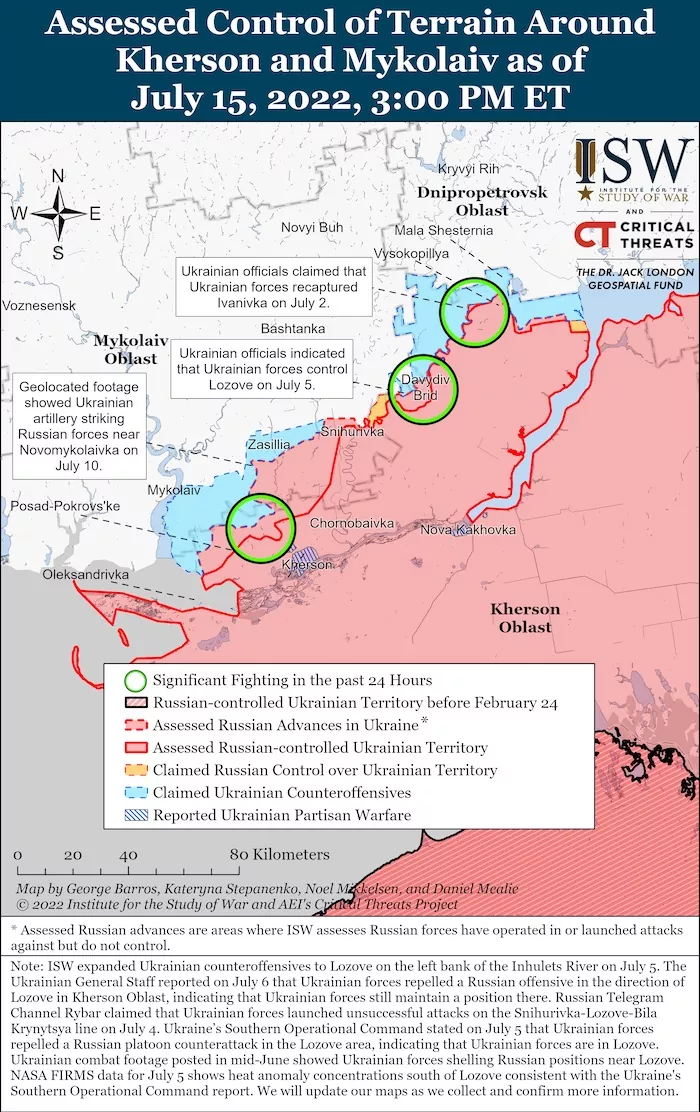
Forty-four localities of the Kherson region have been liberated, Ukrinform reports. “There are territories, populated localities that have been liberated. I rely exclusively on official data agreed with the General Staff. These are 44 localities, Dmytro Butriy, acting head of the Kherson Regional Military Administration, said. The localities belong to Velyka Oleksandrivka, Kochubeyivka, Novovorontsovka territorial communities.”
Russia fired 630 Iskander and Kalibr missiles at Ukraine since the war began, Ukrinform reports. “Since the beginning of the full-scale invasion, Russia has fired 630 Iskander and Kalibr cruise missiles at Ukraine, Oleksiy Hromov, Deputy Chief of the Main Operations Department of the Ukrainian General Staff, said”
Created in three days, Ukraine’s territorial defense ruined Russian plans to capture Kyiv
According to British Defence Intelligence, (last 48 hours):
- Russian offensive operations remain reduced in scope and scale, with fighting west of Lysychansk focussed on Siversk and Bakhmut. This is despite Russian claims to have entered the outskirts of Siversk town earlier in the week.
- Russia has previously made premature and false claims of success. This is likely at least in part aimed at demonstrating success to domestic audiences and to reinforce the morale of the fighting forces.
- Ukrainian defence has been successful in repulsing Russian attacks since Lysychansk was ceded and the Ukrainian defensive line was shortened and straightened. This has allowed for the concentration of force and fires against reduced Russian attacks and has been instrumental in reducing Russia’s momentum.
- In the Donbas, Russian and pro-Russian Luhansk People’s Republic separatist forces claim to have entered the outskirts of Siversk. This has not been corroborated, however, Russian forces have been slowly advancing westwards following shelling and probing assaults towards Siversk from Lysychansk to open a pathway onward to Sloviansk and Kramatorsk. Bakhmut is likely to be the next objective, once Siversk is secured.
- Since withdrawing from the strategically located Zmiinyi (Snake) Island on 30 June 2022, Russia has been attempting to deny its use by Ukraine. However, on 13 July 2022 airstrikes by two Su-27 Russian fighter jets failed to hit the island. This follows the pattern of Russian air forces failing to successfully engage in the tactical battle.
- Over 2.5m people have now been evacuated from Ukraine to Russia since the start of the invasion. Russia continues to face accusations that it is forcibly deporting Ukrainians; in many cases Ukrainians have reportedly been mistreated in filtration camps set up by Russia.
Losses of the Russian army
As of Saturday 16 July, the approximate losses of weapons and military equipment of the Russian Armed Forces from the beginning of the war to the present day:
- Personnel – more than 38140 (+140),
- Tanks – 1677 (+5),
- Armored combat vehicles – 3874 (+8),
- Artillery systems – 846 (+4),
- Multiple rocket launchers –MLRS – 247 (+0),
- Air defense means – 109 (+0),
- Aircraft – 220 (+1),
- Helicopters – 188 (+0),
- Automotive technology and fuel tanks – 2735 (+4),
- Vessels/boats – 15 (+0),
- UAV operational and tactical level – 687 (+6),
- Special equipment – 68 (+1),
- Mobile SRBM system – 4 (+0),
- Cruise missiles – 162 (+7)
Russian enemy suffered the greatest losses (of the last day) in the Bakhmut direction.
Armed Forces of Ukraine suffered their greatest losses in May – Defence Minister, Ukrainska Pravda reports, citing BBC Ukraine. “Oleksii Reznikov, the Minister of Defence of Ukraine, says that the Armed Forces of Ukraine suffered their greatest losses in the conflict with the Russian invaders in May of this year when up to 100 soldiers were being killed and 300-400 wounded per day.
The Minister of Defence admitted that the occupiers had a significant advantage at that time, especially on the Donetsk front – the invaders were using up to a thousand artillery shells per hour. The Armed Forces of Ukraine did not have that number of shells.”
Over 3,500 Ukrainian warriors received state awards posthumously – Zelenskyy, Ukrainska Pravda reports. “Since the beginning of the full-scale Russian invasion, 23,000 Ukrainian defenders have been decorated with national awards. 3,500 warriors received the award posthumously. Ukraine has not revealed the total number of deceased military personnel so the aggressor state does not use this information for analysis and planning.”
Humanitarian
Russian troops shell Nikopol from missile launchers installed on territory of Zaporizhzhia NPP
Energoatom CEO Petro Kotkin said this on the nat'l newscast. 500 Russian soldiers are stationed at the nuclear plant with heavy equipment, weapons, explosives https://t.co/0bOJR2adhY pic.twitter.com/NKA5kz3EJJ
— Euromaidan Press (@EuromaidanPress) July 16, 2022
Russia resumes long-range bombardment of Ukrainian cities, Reuters reports. “Russian forces shelled the southern Ukrainian city of Nikopol on Saturday, the latest in a series of bombardments of urban areas that have killed at least 37 people in the last three days and wounded scores.
Ukrainian emergency services said two people were wounded and another two were trapped under rubble in Nikopol, which is on the Dnipro River.
Late on Friday, Russian missiles hit the city of Dnipro, about 120 km (75 miles) north of Nikopol, killing three people and wounding 15, regional Governor Valentyn Reznychenko said on Telegram.
A Russian strike hit the northeast Ukrainian town of Chuhuiv in Kharkiv region overnight, killing three people including a woman of 70, and wounding three more, the regional governor said. The strike damaged a residential block, a school and a shop, and rescuers were going through the rubble, Governor Oleh Synehubov said on Telegram.
The attacks were the latest in a series of Russian hits in recent weeks using long-range missiles on crowded buildings in cities.
Eight people were killed and 13 injured in a string of shellings in 10 locations in the eastern region of Donetsk, Governor Pavlo Kyrylenko said in a television interview on Friday.
On Thursday, Kalibr cruise missiles launched from a Russian submarine in the Black Sea hit an office building in Vinnytsia, a city of 370,000 people about 200 km (125 miles) southwest of Kyiv. Kyiv said the strike killed at least 23 people and wounded dozens.”
https://twitter.com/EuromaidanPress/status/1547992569035968512
️️Environmental
The total amount of documented damages is $95.5 billion, minimum recovery need for destroyed assets is $165.1 billion, Kyiv School of Economics reports. “In the total amount of damages, the largest share is caused to residential buildings — 38% or $36.6 bln. Almost 121,000 residential buildings, homes for almost a million families, have already been destroyed and damaged as a result of hostilities. In second place in terms of damage is infrastructure – $31.3 bln.
Missile attacks cause crucial damage to the industry, infrastructure, and other assets. Damage to businesses amounts to at least $8 bln and is growing rapidly. These are the damages to small businesses, as well as large and medium-sized enterprises of state and private ownership, based on the received microdata. Another $4.3 billion — damages caused to the agricultural sector and agro-enterprises.
Since the beginning of Russia’s war against Ukraine, at least 388 enterprises, 18 civilian airports, 779 medical institutions, 1,371 educational institutions, 690 kindergartens, 23 shopping centres, 28 oil depots, 105,200 private cars, 563 cultural and religious facilities have been damaged, destroyed or seized.
At the same time, as of July 5, 43 bridges have already been restored and 941 km of state roads have been demined, according to the Ministry of Infrastructure of Ukraine.
For the first time, a preliminary assessment of losses and recovery needs is presented. The total preliminary assessment of losses of Ukraine’s economy is $126.8bln or UAH 3.7 trillion. After all, a complete or partial shutdown of a significant number of enterprises and institutions leads to a complete or partial shutdown of enterprises’ activities, loss of income, and an increase in expenses related to the war (for relocation, assistance to employees, etc.).
According to preliminary KSE Institute team estimates, the recovery needs for destroyed assets is at least $165.1 bln or UAH 4.8 trillion. This assessment takes into account only the reconstruction of destroyed objects, technological modernization, and the additional need for liquidity for business entities to resume their activities. Another limitation of the current assessment is that it does not take into account the introduction of new standards in the construction of roads, public facilities, and modernization needs not directly related to the wartime consequences.
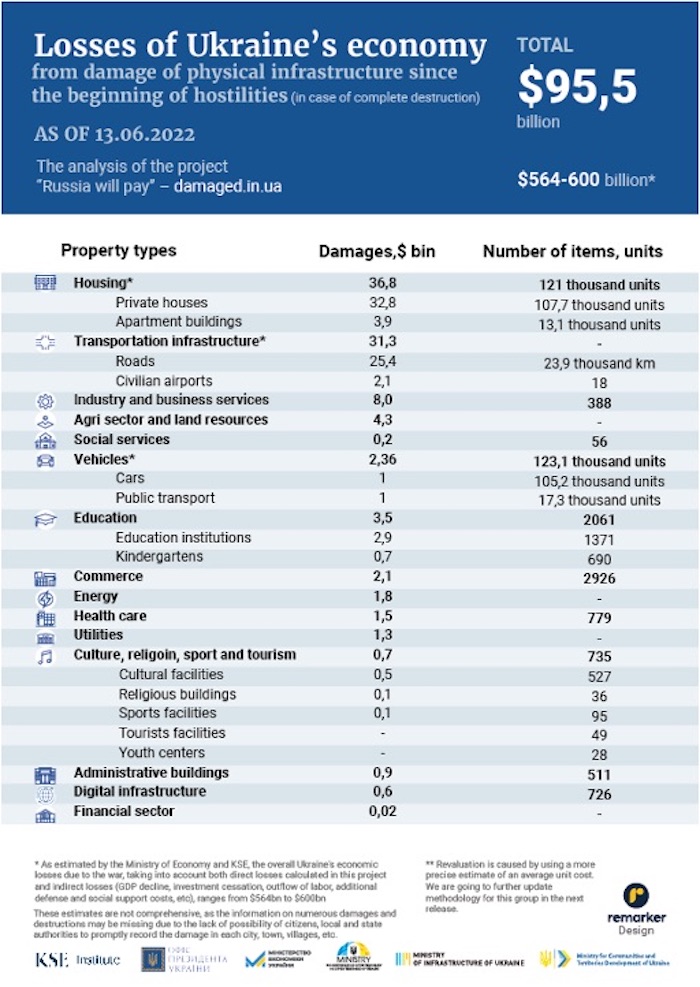
As well, these estimates do not take into account the damages and needs for the ecology, in particular the forest fund, and the demining needs of all land, water objects, and buildings (except modest estimates for agricultural sector and coastal tourist zones). According to the preliminary World Bank’s assessment, demining all territories requires more than $70bln.
According to the government’s estimates presented in Lugano, the total cost of rebuilding Ukraine is approximately $750 billion. This amount includes not only the cost of rebuilding the destroyed facilities but also the need for fiscal support, modernization, and strengthening capacity of key economic sectors, as well as assistance to resume business and enterprise activities.”
Are sanctions against Russia working? What have they achieved? An explainer
As a Ukraine grain deal emerges, the US aims to ease concerns over Russia sanctions, Reuters reports. “The United States on Thursday sought to facilitate Russian food and fertilizer exports by reassuring banks, shipping and insurance companies that such transactions would not breach Washington’s sanctions on Moscow over its invasion of Ukraine.
Enabling those Russian exports is a key part of attempts by the United Nations and Turkish officials to broker a package deal with Moscow that would also allow for shipments of Ukraine grain from the Black Sea port of Odesa, which has been blockaded by the war. The written US clarification came a day after Russia, Ukraine, Türkiye and UN officials met in Istanbul for talks aimed at resuming Ukraine’s grain exports.”
Germany’s gas crisis generates a nuclear dilemma for the ruling Greens, Reuters reports. “Germany’s three remaining nuclear power plants are scheduled to be shut down by the end of the year after former chancellor Angela Merkel pledged to halt the use of nuclear electricity after the Fukushima nuclear disaster of 2011. The plants accounted for 6% of Germany’s electricity production in the first quarter of 2022. The debate over keeping the plants running began after Russia’s invasion of Ukraine started on Feb. 24 and prompted Germany to decide to end its heavy reliance on Russian fossil fuel.
The European Union will next week publish recommendations on how countries can cut gas demand to prepare for winter. A draft of the recommendations, seen by Reuters, said one option would be to postpone the shutdown of nuclear power plants or switch from gas generation to nuclear where possible.
Last month, a poll by RTL/ntv broadcasters showed some 68% of Germans were in favor of reconsidering the country’s nuclear exit.“
Legal
Senior Western officials directly accused their Russian counterparts of war crimes, Reuters reports. “Senior Western officials directly accused their Russian counterparts of war crimes on Friday after Russian missiles struck a Ukrainian city far behind the frontlines in an attack Kyiv officials said killed at least 23 people.
Ukraine said Thursday’s strike on Vinnytsia, a city of 370,000 people about 200 km (125 miles) southwest of the capital Kyiv, had been carried out with Kalibr cruise missiles launched from a Russian submarine in the Black Sea.”
Ministry of Internal Affairs: Russia strikes hit nearly 300 military targets, and 17,300 civilian ones, Ukrinform reports. “Recently, we have seen targeted strikes on civilian objects. I specifically inquired for a summary report on how many Russian missiles hit military targets, and how many engaged civilian ones. For comparison: since the large-scale aggression, there have been 17,314 strikes on civilian targets, and a little more than 300 hits on military targets, the First Deputy Minister of Internal Affairs, Yevhen Yenin, said.”
Russian invaders officially admit that they deliberately targeted civilians in Vinnytsia, Ukrainska Pravda reports, citing the Russian propaganda news agency RIA Novosti. “Yesterday, high-precision Kalibr missiles were fired at the officers’ garrison building in Vinnytsia – a meeting of the Ukrainian Air Force command with representatives of foreign arms suppliers was taking place there at that moment. In their statement, the occupiers boast that as a result of the strike, those attending the meeting were killed.”
According to the Ukrainian Air Force Command, Russia has changed its version three times regarding the consequences of the rocket attack on the Vinnytsia Officers’ House, in which 23 people died on 14 July.
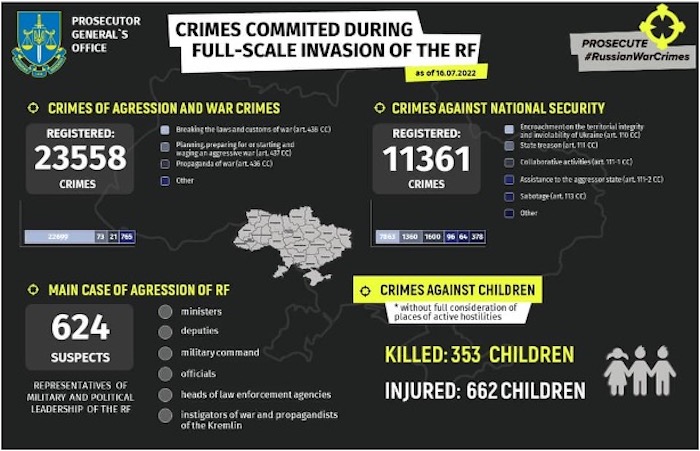
353 children were killed, and 662 children injured, the Office of the Prosecutor General of Ukraine reports as of July 16. 2,138 educational establishments are damaged as a result of shelling and bombings, 221 of them are destroyed fully. 23,558 crimes of aggression and war crimes and 11,361 crimes against national security were registered.
Support
https://twitter.com/EuromaidanPress/status/1548101478748893189
The family of the “long-armed” Ukrainian army has been replenished: the first M270 MLRS has arrived. “They will make good company for HIMARS on the battlefield. Thanks to our partners. There is no mercy for Russian forces,” said Oleksiy Reznikov, Minister of Defense of Ukraine, in a message posted on the official Twitter page on July 15, 2022.
Ukraine undertakes not to strike Russia with HIMARS – the Minister of Defence, Ukrainska Pravda reports citing BBC. “Oleksii Reznikov, the Minister of Defence of Ukraine, has confirmed that Ukraine has undertaken not to use HIMARS on targets on the territory of the Russian Federation. We made a commitment that we would not use high-precision weapons against Russian objects on the territory of the Russian Federation. We have confirmed it everywhere, even I personally did so in a letter addressed to my colleague – the head of the Pentagon – that we will use American weapons to deter Russian forces and de-occupy temporarily occupied lands [by the Russian army] only on the territory of Ukraine.”
Bulgaria, Russia clash over Ukrainian helicopter repairs, Defense News reports. “Russian Foreign Ministry spokesperson Maria Zakharova said in a statement […] that NATO and European Union member countries are supplying weapons and military equipment to Ukraine and planning their repair at plants in Eastern Europe. In response to this, she explained, Russia is suspending permission for two Bulgarian companies and one Czech firm to carry out repairs and maintenance of Russian-designed helicopters. The statement implies that Russia will also no longer provide spare parts.
Bulgaria’s defense capabilities will not be seriously affected by Moscow’s decision to suspend Russian helicopter repair certificates to local companies, the defense minister said Friday. Dragomir Zakov said Bulgaria would also continue to repair Ukrainian military equipment.”
Ukraine Flies ‘Suicide Missions’ With MiGs, Awaits US Decision on F-16 Training, Air Force Magazine reports. “On Capitol Hill and at the Pentagon from June 19 to 25, two Ukrainian pilots described the challenges they face flying outdated, analog MiG-29s on the front line of a war against sophisticated Russian jets. They were asking for F-16s and the training to fly them.
Ukrainian pilots describe their sorties as “suicide missions” […]. “Every one of us understands that we have lack of capability in old airplanes,” said Nomad, who was not part of the group in Washington, D.C. “The Russian airplanes have much more capabilities. They usually fly beyond visual range. They usually use missiles that have a range of more than 80 miles.”
Nomad described the story of a pilot friend on a recent night mission in the eastern Donbas region who flew with no radar, searching the night sky for a dogfight with a Russian fighter, limited to heat-seeking missiles at visual range. On countless other missions, Nomad said, by the time a Ukrainian pilot has seen the Su-30 or Su-35 jet he is up against, “it has already fired.” […]
Col. Yuri Ignat, chief spokesperson for the Ukrainian Air Force Command, told Air Force Magazine that Ukraine has at least 30 pilots with sufficient English-language skills ready to travel to the United States for fighter pilot training along with the corresponding engineers and maintenance teams if a deal can be struck. To learn the first stage of takeoff and landing and flying from point A to point B, it will take a few weeks, but to learn how to fight on it, to learn how to use missiles, we will take around six months, Ignat said by videoconference from Ukraine’s Air Force headquarters in Vinnytsia, Ukraine.
Ignat said the Ukrainian Air Force flies in squadrons of 12 aircraft, and it believes two F-16 squadrons plus reserve platforms would turn the tide of the war with Russia. He said the transfer of F-16s, either by the United States or another nation, would ultimately require US approval.
We are defending our cities with fighter jets, those cities like Zaporizhzhia, Mikolaev, the cities that are under the Ukrainian control,” he said, referring to front line cities threatened by Russia in the south and east of Ukraine. We also will need these fighter jets to use for the de-occupation of our territories,” he said. “We are not speaking about attacking territories, but we are speaking about de-occupying those that are Ukrainian.”
NBU: Ukraine has received almost $13B in aid since the beginning of the war, Ukrinform reports. “The international aid intensified at the end of June. Thanks to this, Ukraine received about $4.4 billion in June and in the first days of July. In total, since the beginning of the war, the country has received almost $13 billion in aid, Deputy Governor of the National Bank of Ukraine Serhiy Nikolaychuk told BBC in an interview.
Nikolaychuk emphasized that war is an objectively expensive thing because the government spends significant funds on defence and security: on the purchase of weapons and equipment, on salary of service members, and transportation.
As reported, since the beginning of Russia’s full-scale aggression, the total amount of declared and provided aid to our country from international partners totaled $30 billion as of mid-June.”
Reznikov refutes the smuggling of Western weapons from Ukraine and promises better control, Ukrainska Pravda reports, citing Financial Times. “In response to Western concerns, the Minister of Defence of Ukraine Oleksii Reznikov has assured that Ukraine is not smuggling weapons received from foreign partners intended for its defense against Russia. We need to survive. We have no reason to export weapons from Ukraine.
Reznikov reported that some allies had sent their military representatives to Ukraine to monitor the flow of weapons provided by them. In addition, he added, Ukraine uses NATO software acquired in 2019 to monitor the deployment and use of weapons provided by the West, and NATO countries have access to this information.
According to Reznikov, the operational scope of this system, which is currently being managed centrally, will be extended to the level of brigades and, possibly, battalions. Kyiv will consult with partners on how far to extend it. Ukraine is also developing two more tracking systems that will work in parallel with NATO software. The Minister insists that there is no chance of heavy weapons being stolen from Ukraine, as they have GPS trackers and Western military satellites can track them.
According to the Financial Times, representatives of the EU and NATO have expressed a desire for Kyiv to better monitor weapons received from the West, as there are concerns that they are being smuggled out of the country to the European black market.”
New Developments
Moscow turns to regions to replace losses and boost forces in Ukraine
- ‘Putin’s War Must Be a Strategic Failure,’ Biden Says in Israel, The New York Times “Putin’s assault on Ukraine is a challenge to the peace and stability everywhere in the world, Mr. Biden said at a news conference in Jerusalem after meeting with Prime Minister Yair Lapid of Israel. “Putin’s war must be a strategic failure. The free world must sustain a resolve to help Ukraine defend its democracy, Mr. Biden said, adding that the United States will continue to support Ukraine and the Ukrainian people who have been devastated and displaced by the Russian violence.”
- Shmyhal calls on the EU to recognize Russia as a terrorist state, Ukrinform “During a video call with EU High Representative Josep Borrell, I called on the EU to recognize Russia as a terrorist state. After all, its army systematically commits terrorist acts against the civilian population. Missile attacks on the centre of Vinnytsia, universities in Mykolaiv, a shopping centre in Kremenchuk, and the railway station in Kramatorsk are all terrorism, which should receive an appropriate international definition, Ukrainian Prime Minister Denys Shmyhal said.”
- Zelensky calls on international partners to impose new sanctions on Russia as soon as possible, Ukrinform “Terror is a virus. And if one of the terrorists goes unpunished, it only encourages others. New sanctions [for terror] are needed as soon as possible, President of Ukraine Volodymyr Zelensky said in his latest address. At the same time, the President underscored that the special tribunal on Russian aggression and a special compensation mechanism that will direct the funds of the terrorist state to those whom it wanted to destroy is also needed.”
https://twitter.com/EuromaidanPress/status/1548165780159725568
- Europe ‘shot itself in the lungs’ with sanctions on Russia, Orban says, Reuters Ukraine needed help, but European leaders should reconsider their strategy, as sanctions have caused widespread damage to the European economy without weakening Russia or bringing the months-long war closer to any resolution, Hungarian Prime Minister Viktor Orban said on Friday. “The sanctions do not help Ukraine, however, they are bad for the European economy and if it goes on like this, they will kill off the European economy, Orban said. What we see right now is unbearable.”
- Ukrainian MFA replied to Orbán: Russia’s war is killing the European economy, not the sanctions, European Pravda “Sanctions help bring the aggressor state to justice for its crimes, as well as weaken its ability to continue the war. It is not the sanctions killing the European economy but Russia’s hybrid war, [the spokesman of the Ministry of Foreign Affairs of Ukraine, Oleh Nikolenko] said. According to him, the Prime Minister of Hungary should not call for lifting sanctions against Russia while the Russian army is cold-bloodedly killing Ukrainian children in Vinnytsia, Kharkiv, Mykolaiv, and other cities. On the contrary, he should call for increasing effective measures to deter aggressive Russian policy. […] Russia is solely responsible for the war. And only by forcing it to peace thanks to joint efforts and unity can we guarantee that Ukraine, Hungary, and Europe, in general, will return to normal life,” Nikolenko added.”
- IMF says it expects Ukraine to keep paying debt despite default speculation, Reuters “The International Monetary Fund expects Ukraine to continue to service its foreign debt, an IMF spokesman said on Thursday as speculation grows that Kyiv could default on its debt as its battle against Russia’s invasion rages on.
- Russia attacks UK and US for training Ukrainian soldiers, calling it ‘hybrid warfare’, SkyNews “Russia’s foreign ministry has attacked the United States and Britain for helping train Ukraine’s armed forces, calling it part of “hybrid warfare” being waged by NATO countries against Russia.”
Dialogue Group on Accountability for Ukraine created in The Hague – Venediktova, Ukrinform reports. “Forty-five countries participating in the conference in The Hague agreed on the Political Declaration on cooperation to achieve a common result. The Dialogue Group, created at this event, should unite national, European, and international initiatives for documentation and justice for international crimes, Prosecutor General of Ukraine Iryna Venediktova posted on Facebook. As noted, the work of the Group will be led by the Prosecutor General’s Office.”
https://twitter.com/EuromaidanPress/status/1548264933699325952
Assessment
- On the War
The Institute for the Study of War has made the following assessment as of Friday 15 July:
“Russian forces are likely emerging from their operational pause as of July 15. Russian forces carried out a series of limited ground assaults northwest of Sloviansk, southeast of Siversk, along the T1302 Bakhmut-Lysychansk highway, southeast of Bakhmut, and southwest of Donetsk City. These assaults may indicate that Russian forces are attempting to resume their offensive operations in Donbas. The assaults are still small-scale and were largely unsuccessful. If the operational pause is truly over, the Russians will likely continue and expand such assaults in the coming 72 hours. The Russians might instead alternate briefer pauses with strengthening attacks over a number of days before moving into a full-scale offensive operation. A 10-day-long operational pause is insufficient to fully regenerate Russian forces for large-scale offensive operations. The Russian military seems to feel continuous pressure to resume and continue offensive operations before it can reasonably have rebuilt sufficient combat power to achieve decisive effects at a reasonable cost to itself, however. The resuming Russian offensive may therefore fluctuate or even stall for some time.
Ukrainian HIMARS strikes have likely killed or wounded four Russian 106th Airborne Division deputy commanders. Russian news outlets reported the deaths of 106th Division’s deputy commanders Colonel Sergey Kuzminov, Colonel Andrey Vasiliev, and Colonel Maxim Kudrin, seemingly confirming Ukrainian claims that HIMARS strikes on Shaktarsk on July 9 killed or wounded a significant portion of the 106th’s leadership. Ukraine’s Center for Strategic Communications claimed on July 12 that one unspecified 106th Airborne Division deputy commander remains in critical condition.
Key Takeaways
- Russian forces are likely emerging from their operational pause, launching ground assaults north of Sloviansk, southeast of Siversk, around Bakhmut, and southwest of Donetsk City.
- Russian forces continued to defend occupied positions in the Kharkiv City direction to prevent Ukrainian forces from advancing toward the Russian border in Kharkiv Oblast.
- Russian forces continued their systematic attacks on civilian infrastructure targeting residential infrastructure, recreational facilities, and educational institutions in Mykolaiv City on July 15.
- Chelyabinsk Oblast officials announced the completion of a volunteer battalion on July 15.
Russian occupation authorities continued to institute new societal control measures in occupied territories.“
The Russian Federation is ready to sacrifice its soldiers so as not to bring disgrace upon itself, Radio Liberty reports. Radio Liberty published a recording of a conversation between the commander of the 41st Army of the Russian Federation, Oleg Korotkevich, in which he declares that the withdrawal of Russian troops from Ukraine will be a total humiliation for Russia. He claims that the Russian Federation will continue to sacrifice its soldiers to prevent this.
“What can we do? All that has been done, all in vain? Because our state, like a beaten dog, will have to leave from there, do you understand? We just can’t afford it, no matter how hard it is, — said Korotkevich.”
2. Consequences and what to do?
Hans Petter Midttun:
The US and its allies have been facing several strategic dilemmas since the war started on 20 February 2014. One of the reoccurring ones is connected to the “fear of escalation of the war into a full-fledged conflict between Russia and NATO”.
The West did not help Ukraine rebuild its Armed Forces and reestablish deterrence during the first 8 years of the conflict, due to the supposed “risk of escalation”. It was claimed that arming Ukrainians would lead only to further violence and instability, and possibly a dangerous confrontation with Russia. One argued that this would make a conflict that (allegedly) was mostly frozen into a more deadly one and would complicate “any reasonable chance of a diplomatic resolution”. The heads of state of both Germany, France, and the USA (until 2018) argued persistently against sending weapons to Ukraine as this supposedly would not contribute to a resolution of the crisis.
They were mistaken. The Minsk Agreement was not designed to ensure peace. It was put in place to both stop NATO from intervening according to its strategic concept and to supply Ukraine with arms.
While the West has been forced into action by the Russian full-scale invasion on 24 February, it still argues that a direct NATO intervention would lead to the risk of a broader conflict.
“Biden’s administration is pushing the world to the brink of the nuclear conflict by waging a “proxy war” with Russia via weapons supply to Ukraine, former US congresswoman Tulsi Gabbard warned [yesterday]. The American people need to understand the seriousness of the situation that the Biden administration and leaders in Washington have put us in,” Gabbard said in an interview with American broadcaster Fox news.
US should pull out of NATO instead of waging a proxy war with Russia, United States’ Georgian Republican Representative Marjorie Taylor Greene earlier said in a controversial statement.”
The USA and Europe will soon face yet another dilemma. They have for months denied Ukraine long-range weapons over fear that it might attack military targets in Russia.
“Russia” in this context is not the territory, airspace, and territorial waters as defined by its internationally recognized borders. It is the area the Russian Federation recognizes as its own – irrespectively of its legal status – and that if attacked, therefore, might trigger pre-planned military responses.
In the same way that it considers Crimea to be Russian territory, it will also see Luhansk, Donetsk, Zaporizhzhia, and Kherson as Russian the moment the four Ukrainian oblasts have been illegally annexed and integrated. If the USA and Europe continue upholding the notion that Ukraine cannot be supplied weapons that might attack targets in “Russia”, it will soon face problems supplying any weapons at all.
The counter-argument would be that the international community would never recognize the occupied territories as Russian. While that is true, its “illegal” status and our “fear for a broader confrontation” stopped us from delivering the weapons Ukraine needed to de-occupy parts of Donbas or the Crimean Peninsular during the first 8 years. Worse still, it stopped us from supporting Ukraine’s efforts to reestablish deterrence. And it continues to stop us from doing what is needed to end the war.
Denying Ukraine the opportunity to engage military targets on the territory, airspace, and territorial waters of the Russian Federation – not because of international law, but for the fear of further escalation – will ultimately force Ukraine to “fight with one hand tied behind its back”. It might even motivate Russia to speed up the integration process.
Western thinking is at odds with the Russian strategy. It has been trying to avoid a military confrontation with the West for more than 8 years already. The Hybrid War is designed to avoid a confrontation with the West while ensuring victory through the limited use of military power. It is important to bear in mind that the extremely short-lived “Blitzkrieg” in February was supposed to ensure a quick, bloodless victory. The war Russia is presently fighting is the result of a strategic blunder – including the underestimation of Ukraine’s military capability and will to fight – not strategic intent.
Having reverted to its Hybrid War strategy from 2014-22 with a much higher focus on the military element, it is now, more than ever, waging war in the cognitive space. The ambiguity and the duality between the threat of military escalation and the hope of a peaceful resolution are constantly at play to complicate or undermine the decision-making processes making a military response – or even a political response – difficult.
More importantly, Russia’s ability to effectively coordinate the employment of both military and non-military tools makes the latter into a force multiplier. Being militarily inferior to NATO, the ability to synchronize its combined toolkit, combined with risk willingness, a quick decision-making process and military posture, puts Russia potentially on near equal footing with NATO with one huge caveat: It will be on equal footing only as long as the US and Europe follows the Russian Hybrid War script.
Russia might still be victorious as long as NATO refuses to engage militarily. As previously stressed, the longer the war lasts, the bigger the consequences. The “tsunami of ripple effects” might at one stage help convince the West that peace at any cost might be a preferable solution to continued war.
If that happens, it would ensure a strategic win for Putin and a strategic blunder by the democratic world.




